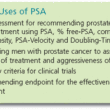The Balance of Harms and Benefits: PSA Screening Intervals and Risk Stratification
Earlier this year, the national media reported on two studies that examined the impact of lengthening PSA screening intervals based on a patient’s PSA value. The studies sought to determine if patients who had low PSA values when they are younger can be screened less frequently, thus reducing the chances of overdiagnosis of indolent cancer, which grows too slowly to cause harm or death.

To understand the power of PSA screening, you have to consider the impact from multiple perspectives.
The theory behind using PSA to stratify future prostate cancer risk—and subsequently adjusting PSA screening—is based on data showing that men with higher PSA levels in midlife, also called a baseline PSA, were more like to develop prostate cancer up to 25 years later. Men with higher baseline PSAs are also more likely to die from the disease.
Data analysis study
One study, published in JAMA Network Open, analyzed data from the Prostate, Lung, Colorectal, and Ovarian (PLCO) Cancer Screening Trial. It is one of the largest study to date to look at a single PSA level taken in “midlife,” when a man is 55 to 60 years old.
The study included nearly 11,000 men who had participated in the PLCO trial. The investigators looked at the PSA values for the men who they first entered the trial, and then tracked how many of them later developed clinically-significant prostate cancer.
After 13 years, men with lower baseline PSAs were less likely to be diagnosed with clinically-significant prostate cancer, and vice versa. Specifically, approximately just 1% of men with baseline PSAs less than 1 ng/mL were diagnosed with clinically-significant prostate cancer. However, with higher PSA values, the incidence rates go up: 5.4% of men with a PSA of 1.00-1.99 ng/mL were diagnosed with clinically-significant prostate cancer, 10.6% of men with a PSA of 2.00-2.99 ng/mL, 15.3% of men with a PSA of 3.00-3.99 ng/mL, and 29.5% of men with a PSA of 4.00 ng/mL and greater.
Based on this data, the authors concluded that men with baseline PSAs less than 2.0 ng/mL could be screened less frequently, and men with a PSA less than 1.0 ng/mL could potentially discontinue PSA screening for prostate cancer.
Study limitations
A major limitation of this study is that so few of the men in the study died from prostate cancer, due to many of the men who participated in the PLCO trial undergoing treatment. In this analysis, only 15 men died from prostate cancer, although 60% of those deaths occurred in men who had a baseline PSA of 2.0 ng/mL or higher. Still, the high levels of treatment in the PLCO skewed the data against PSA screening.
The study also did not analyze other PSA metrics, such as PSA density or velocity. However, a persistently rising PSA is a better predictor of clinically- significant prostate cancer than a single PSA test.
The authors expect to assess 20- year follow-up from the trial in 2022, which could provide more data on prostate cancer-specific death and baseline PSA testing in this population of men.
Other research supports an earlier baseline PSA test. Previous evidence suggests that a midlife PSA test taken when a man is in his 40s is a helpful risk stratification tool. A PSA above the median for a man in his 40s is a stronger risk factor for prostate cancer than age, race, or even family history. The median PSA for a man in his 40s is 0.7 ng/mL.
Statistics modeling study
The second study, published in Journal of the National Cancer Institute, examined similar issues using simulation models of prostate cancer progression, detection, and mortality in comparison to patient data from men in a long-term Swedish prostate cancer research project, the Malmo Preventive Project.
The investigators compared biennial (every two years) screening for men ages 45-69 for men with longer screening intervals for men with a PSA 1.0 ng/mL or greater at age 45. They found that the longer screening intervals led to about 47% fewer tests, fewer overdiagnoses, but saved 3.1- 3.8% fewer lives.
Stopping screening for men age 60 or older who had a PSA lower than 1.0 led to 13-16% fewer tests, 5-20% fewer overdiagnosis, but it saved 5-13% fewer lives.
The authors concluded that PSA could be used to stratify future risk of prostate cancer and adjust the PSA screening strategy accordingly to reduce harms of unnecessary testing and overdiagnosis while preserving the majority of lives saved.
Study limitations
Statistical modeling studies have limitations in accurately reflecting real- world scenarios, which the authors address. Limitations usually derive from the questionable validity of the assumptions they make in their models, which sometimes can yield significantly different estimates of outcomes. Therefore, statistical modeling studies usually are not considered sufficiently rigorous to support hard recommendations for clinical adoption, as compared with prospective, randomized trials.
In addition, the authors’ benefit- harm analysis does not include the frequency of metastases at diagnosis, which is determined only by early detection. Therefore, they fail to consider preventing suffering and treatment of metastatic disease, which is quite burdensome to patients and their families.
Broadening the perspective
New biomarkers and imaging tests are now available, which can be used to improve the performance of PSA screening and more accurately stratify a man’s individual risk for prostate cancer. For example, the Prostate Health Index (PHI) test is more reliable than PSA alone.
Dr. Catalona and his research collaborators are actively working to find and validate genetic markers for prostate cancer. Once validated for clinical use, these approaches could be used to more accurately stratify a man’s’ risk for clinically-significant disease that could cause suffering and/or death, guiding both screening and treatment decisions.
 Dr. Catalona’s Response: The Fuller Picture Still Supports Screening
Dr. Catalona’s Response: The Fuller Picture Still Supports Screening
The true extent of “overdiagnosis” of prostate cancer cannot be determined for individual patients and can only be roughly estimated in populations using the excess number cases diagnosed in the screening arm of a randomized clinical trial as a proxy measure, which is usually inflated because it actually consists of a mixture of overdiagnosed cases and true life-threatening cases.
The natural history of “PSA growth” in prostate cancer patients is that it increases by 2% per year prior to a change point when increases accelerate. After this, PSA increases by 15% in patients presenting with localized disease and 63% in those presenting with metastases. Usually, the change point occurs at PSA levels below 4.0 ng/mL, and the median age at the change point is at 57 years old, occurring in the 40s in many patients.
Screening intervals longer than two years risk delaying the diagnosis of the most aggressive cancers. Recent epidemiologic and clinical results from men who have had a hiatus in PSA testing during the 2010-2018 USPSTF “ban” on PSA testing have revealed a marked increase in patients presenting with advance-stage disease. This makes a recommendation of lengthening screening intervals to four or eight years or completely discontinuing screening when PSA is below 1.0 at age 60 particularly concerning.
JAMA Netw Open. 2020 Jan 3;3(1):e1919284. doi: 10.1001/jamanetworkopen.2019.19284.
J Natl Cancer Inst. 2020 Jan 9;djaa001. doi: 10.1093/jnci/djaa001. Online ahead of print.




















